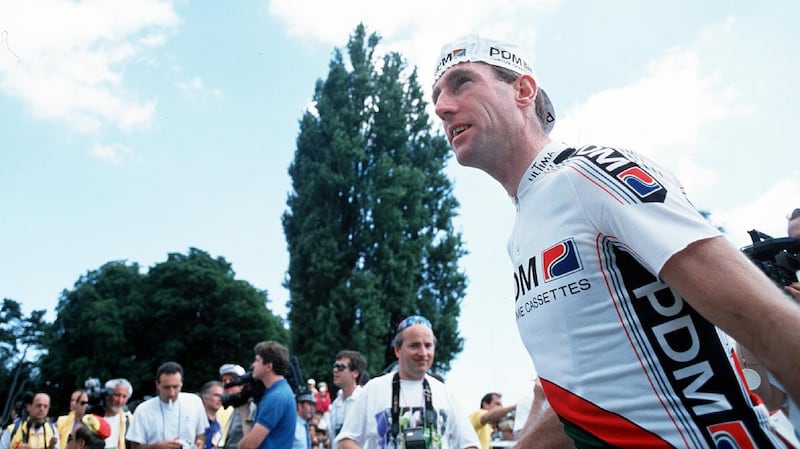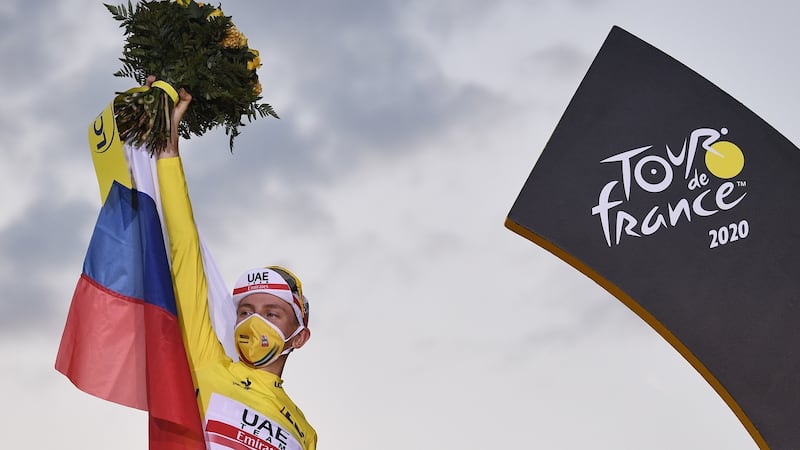Seán Kelly was in the middle of his best-ever season when he had a brutal crash in the Tour of Switzerland.
"I went over a wall on a descent," he told The Irish Times of that crash in 1986 this week. "There were stones pointing up on the top of the wall. One of them reefed me and opened up the side of my calf. I got very, very deep wounds, and needed not just external stitches but also internal ones."
Kelly was known as the toughest of riders, a no-nonsense individual who often just got on with things after falls. He was carved open by the crash but immediately thought of the upcoming Tour de France. Despite the view of experts, he convinced himself he would make it.
“The doctors immediately said it was serious, but you’re hoping when you go back to them after two to three days that they will say, ‘yes there is a really good improvement.’ The miracle might happen that you will be able to go to the start.
"But when you get the final answer it is such a hard one." And that was it. One year after finishing fourth overall in the Tour, weeks after winning Paris-Nice, Milan-San Remo, the Tour of the Basque Country and Paris-Roubaix and netting third overall in the Vuelta a España, what would be his last chance of winning the Tour had gone.

He returned to the Tour in other years but never got close to the podium again. His best chance evaporated in the moment it took him to crash at high velocity and hurtle over a wall in Switzerland. Winning the 1988 Vuelta a España was a consolation, but he’d dearly love to have taken a Tour.
Kelly's disappointment came to mind this week when it was confirmed that another Carrick-on-Suir native would miss the race. Sam Bennett reached the high point of his career thus far last season at the Tour, winning two stages and dominating the points classification.
With much of Irish sport stymied due to Covid, the footage of him tearing up the Champs Elysees in green, fending off all challengers and then punching the air in triumph was one of the standouts of the year. So too his elation, a lot of potential finally being realised.
If Sam is back racing and is winning again, well then he's going to the Vuelta
Bennett kept the momentum going afterwards. He collected a stage at the Vuelta a España last October and then clocked up no less than seven wins this year. He was clearly the best sprinter and was heading towards another Tour brim full of confidence.
And then, in a bizarre accident earlier this month, his chance was gone. “He bashed his knee off the handlebars,” Kelly explains. “I think the chain came off, he was doing some sort of sprint-practising efforts. When that happens you get a real smack off the handlebars. I did it in my day and riders are still doing it. If the chain hops, if the chain comes off, it can happen. And to hit the kneecap off the handlebars is a sore thing.”
Slump
Indeed the same kind of accident saw Stephen Roche withdraw from the 1989 Tour de France, two years after winning the race.
Bennett has been in a bit of a slump in recent days, something that was likely compounded by his Deceuninck-QuickStep team manager mouthing off to the press. Patrick Lefevere is well known for venting and ranting; when times are good, he's a rider's best friend, but things can veer in the other direction when there are problems. But for Kelly, it's a question of revenge too: Bennett will leave the team later this year as Lefevere can't match the contract offers of other squads.
“What Lefevere is saying is because of the way things are turning out. If Sam had re-signed and was in for another two years, there wouldn’t be any of those words,” he says. There is truth in that.
Still, it’s tough for Bennett. The Tour rolls out of Brittany on Saturday and over the next three weeks, there will be eight stages tailor-made for the sprinters. That’s a lot of time for reflection, a lot of time to agonise over lost chances.
“It is really hard,” Kelly underlines. “You are thinking, ‘if the injury didn’t happen, what way would things go?’ And you’ll still be thinking about it as the race goes on. You wouldn’t watch it every day because you don’t want to be f*cking watching every stage, but you would still be hearing about the race, of course.
“You’d just be thinking to yourself, ‘how would I have done against those guys on that stage?’ It is very, very hard.”
So what should Bennett do to move on? “Well, I think he just has to get the injury sorted out,” Kelly answers. “With an injury, it is good if you can just take the time out to fully recover. And then just get back and start focusing on the rest of the season. For all Lefevere is saying, if Sam is back racing and is winning again, well then he’s going to the Vuelta.”
Bennett is young enough and fast enough and hungry enough to triumph again. Stage wins at this year’s Vuelta a España would be a strong fight-back, and then there will be a refocusing on next year’s Tour. Kelly may have lost his best chance with his Swiss fall, yet the feeling remains that Bennett’s Tour successes are far from over.
Five contenders for the yellow jersey:
Tadej Pogacar (UAE Team Emirates, 22): The Slovenian starts the Tour as defending champion after becoming the second-youngest winner in the history of the race last year. His Tour debut also saw him become the first rider to take the yellow, white and polka-dot jerseys as overall winner, best young rider and king of the mountains. He has continued his momentum this season by winning Liège-Bastogne-Liège Classic plus the UAE Tour, Tirreno-Adriatico and the recent Tour of Slovenia.

Primož Roglic (Jumbo-Visma, 31): The former ski jumper led last year's Tour for 11 days and appeared set for overall victory until compatriot Pogacar stunned in the penultimate stage time trial. Roglic ran out of steam on the uphill test to La Planche des Belles Filles, placing only fifth, and finished as runner-up in Paris. He had another unexpected French upheaval this year when he lost Paris-Nice on the final day despite dominating the race; he crashed twice on the last stage, dislocating his shoulder. He hasn't raced since Liège-Bastogne-Liège on April 25th, preferring instead to train at altitude.
Richard Carapaz (Ineos-Grenadiers, 28): While Carapaz doesn't have quite the star status as Pogacar or Roglic, he is the winner of the 2019 Giro d'Italia and was runner-up to Roglic in last year's Vuelta a España. He showed strong form recently when he won a stage plus the overall classification in the Tour de Suisse, being considerably aided by Irish teammate Eddie Dunbar. The Ecuadorian's greatest advantage is being part of the dominant Ineos-Grenadiers team, although that means he shares leadership with two others.
Geraint Thomas (Ineos-Grenadiers, 35): Winner of the 2018 Tour de France and second overall the following year, Thomas has prospered in a way that few expected earlier in his career. He missed last year's Tour when he and his team decided he would focus instead on the Giro d'Italia, but he crashed out of that event. Indeed crashing is a somewhat regular occurrence for Thomas and while he has shown strong form this year in winning the Tour de Romandie and netting third overall in both the Critérium du Dauphiné and the Volta a Catalunya, he will need to stay upright to challenge for yellow.
Richie Porte (Ineos-Grenadiers, 36): Porte has tried on several occasions to win the Tour de France and was in a strong position in 2017 when he crashed out on stage 9 to Chambéry. Supporters of Dan Martin will remember the fall as the one where Porte inadvertently took down the Irishman; Martin suffered fractures to two vertebrae but still finished sixth overall in Paris.
Porte finally made a breakthrough last year when he placed third overall in the Tour, yet appeared to give up team leadership when he moved back to Ineos-Grenadiers (formerly Team Sky). However victory in the recent Critérium du Dauphiné highlights his strong form and he starts as a yellow jersey contender.
Five key stages:
Stage eight, Saturday July 3rd, Oyonnax - Le Grand-Bornand (150.8km)
This first mountain stage comes three days after a flat 27.2 kilometre time trial to Laval and provides an opportunity for the climbers to try to regain any time lost. However although there are multiple peaks, the highest of these, the Col de la Colombière, is just 1,618 metres high and is followed by a long descent to the line. There should be a thinning out of riders, yet likely no major time gaps within the general classification contenders.
Stage 11, Wednesday July 7th, Sorgues - Malaucène (198.9km)
The stage to Malaucène comes after two somewhat muted days in the Alps and features a double ascent of Mont Ventoux. The mountain is where the former world champion Tom Simpson died during the 1967 race, and is a regular feature in the Tour. It has never been scaled twice during a Tour stage and the organisers will hope for fireworks. The decision to end with a descent to the finish may allow the most daring to limit their losses.
Stage 17, Wednesday July 14th, Muret - Saint-Lary-Soulan (178.4km)
This tough Pyrenean stage features three peaks, including the hors categorie (above categorisation) summit finish at Saint Lary Soulan/Col du Portet. The first half of the day is flat to undulating and may enable a break to build enough of a buffer to dispute the stage win, while the trio of summits in the finale should wreak damage amongst the contenders.
Stage 18, Thursday July 15th, Pau - Luz Ardiden (129.7km)
Coming on the heels of the stage to Saint-Lary-Soulan, this provides further opportunity to either strengthen a grip on the yellow jersey or to attack it. While there are just two mountains of note during this relatively short stage, the hors category ascents of the Col du Tourmalet and Luz Ardiden will really shake things up.
Stage 20, Saturday July 17th, Libourne - Saint-Émilion time trial (30.8km)
The second of two time trials in the race comes on the penultimate stage and, like last year’s uphill race against the clock, could see the race leader deposed. This time the route is completely flat and should provide opportunity for an all-rounder to make gains on the specialist climbers. The margins in the general classification at that point will determine whether or not this will be enough to determine the final standings.
With only the last sprinting stage to Paris to follow, the Tour’s top 10 will be settled on this stage.











